Directly to Mars. Meeting with the President of the Mars Society in Moscow
 Bashny.Net
Bashny.Net
"Today in Moscow Memorial Museum of Cosmonautics Russian candidates MarsOne project met its founder Bas Lansdorpom. Remotely in the meeting was the project adviser Robert Zubrin, founder of the Mars Society. He briefly spoke about his project Mars Direct - available with existing technologies and budgetary practices manned flight to Mars. And send everyone to the details made me a transcript of the meeting in Skolkovo 21 October. After a magical pink magisterludi post the transcript of that meeting Habré ».
& Quot; In American history, the important role played by the pilgrims who came to Massachusetts in their honor every year we celebrate Thanksgiving. In the book, the governor of Massachusetts, William Bradforta, he wrote a book about the pilgrims that once something they did not like in the world, and they decided to move to a deserted place. Many have responded to this call, many were frightened and resisted this idea. And we can conclude that the great and worthy of veneration actions are always accompanied by severe hardship. This book describes the process of how beliefs helped to create an enclave of civilization in America. I> & quot;
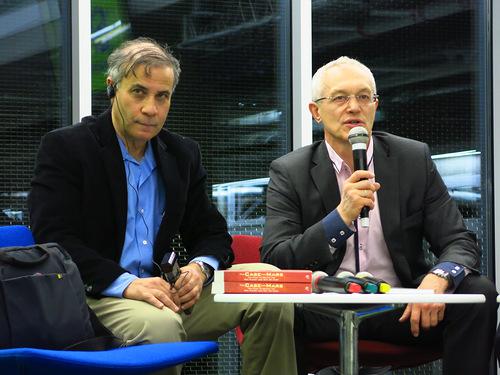
Robert Zubrin (Mars Direct) and Sergei Zhukov (astronaut, head of the Skolkovo space cluster)
October 21, 2013 in Moscow, at a meeting of the Club of Friends of outer cluster Skolkovo Foundation, held a meeting with Robert Zubrin.
Robert Zubrin - American aerospace engineer and author. Project Leader Mars Direct and president Mars Society
Winner of a number of patents in the field of Aeronautics and Astronautics.
In 2010, Zubrin with Carl Sagan , Brian Cox and Penelope Boston have been shown in scientific video« The Case for Mars »project Symphony of Science.
Regalia: B.A. in Mathematics (1974), a M.S. in Nuclear Engineering (1984), a M.S. in Aeronautics and Astronautics (1986), and a Ph.D. in Nuclear Engineering (1992)
Zubrin Those of you who are interested in opportunities in the past missions to Mars have heard about the huge spaceships with grandiose huge engines that will be built for this purpose in orbit. Such technologies and work on this scale is not feasible in the near future. But I do not believe that such work is now necessary and appropriate. My colleagues and I considered various options spaceflight and different implementation of previous programs, good and bad. And we thought, why such a mission to Mars expensive. Of course, many developers want to sell their technology to carry out missions to Mars. But we need to review and select what is really expedient.
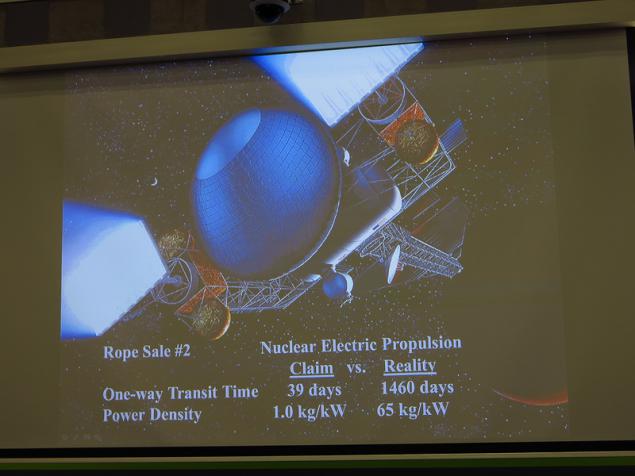
To build a ship, of course need a booster, which will bring it all into space. We and my colleagues tried to assess which components of the necessary and sufficient. We came to the conclusion that for a flight to Mars need four engines, two launch vehicle, and tanks with fuel and oxygen are the same as used in the project Saturn 5. There are different options for the location of engines. Such a construction would raise about 140 tons from the surface of the earth and deliver about 47 tons of cargo to Mars - these calculations were carried out in accordance with this carrying capacity. Until now, no one delivered a cargo space and forwards it to another planet. We just ran loads in near-Earth space. And if you make this kind of calculation, it is necessary to take into account all the stages of the path.
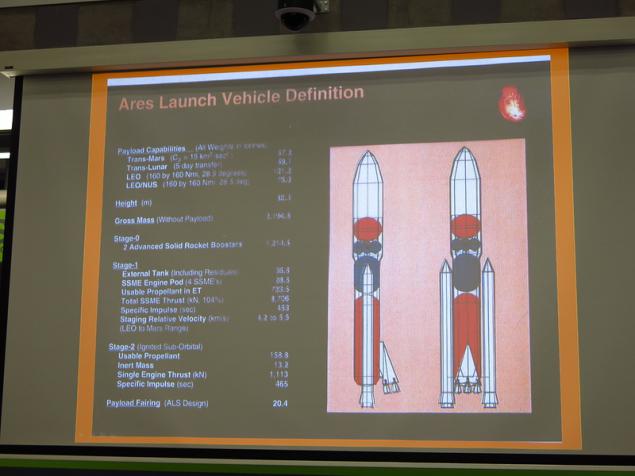
But if the mass of the ship and cargo weight to be delivered to Mars will not tens or hundreds of thousands of tons - if we can lift the weight from Cape Canaveral or other spaceports? Probably, it is possible to divide the cargo into 8 pieces, take them individually into orbit, to gather there and then deliver the goods to Mars. These projects were proposed previously, but now forgotten. The risk is too great - if at least one of the eight startups will fail - you will fail the entire mission. We are currently developing a mission with only two runs and thinking about the fact that both were successful launch. Not have to use just such missiles, but the class must be suitable capacity.
Why is being developed in other missions ships so great? Most ships are calculated taking into account the fuel to transport people to Mars and back. But here we can turn to the experience of travelers in the past. Do they always took with them all for yourself and expeditions, including the power of horses, all the way? No, the travelers were trying to be self-sufficient and get everything you need in place. Mars - the planet, which has the necessary resources and that can be a part of our process chain. Why do not travel light, and to facilitate the carrying capacity of our mission, we take as a basis for the concept of self-sufficiency.

First we went to Mars unmanned missiles and 40 tons of cargo. The rocket will fly to Mars, will slow down in the Martian atmosphere, and we Martian orbit with the help of a parachute capsule descended to the surface of Mars, as we have done so in 1996 and as Curiosity planted last year. We will deliver the goods, the capsule for the return flight from Mars, 5 meters in diameter, in which the two decks, a compartment for crew support for 4 people. This capsule is designed for travel from Mars to Earth for 6 months, and it will provide empty compartments for fuel.

Why do we send Slots? Otherwise, the weight of our apparatus would significantly increased. In these compartments will be 6 tons of hydrogen and a compartment with a small nuclear plant. After the rocket will land on Mars, a special robot will be able to deploy a nuclear power plant. When the power plant is established in the crater or recessed, we can start it and use it to run a chemical plant, which will produce carbon from the atmosphere and using hydrogen brought obtain methane. This is a known Sabatier exothermic reaction that does not require additional energy and passes it to the catalysts that we can also pick up. In this reaction, we obtain water and methane. Electrolysis of water, we get oxygen, which becomes fuel for the return trip and the remaining hydrogen, we will gather and store in a special compartment. Of carbon dioxide in the atmosphere of Mars, we also obtain oxygen by decomposing it into oxygen and carbon monoxide.
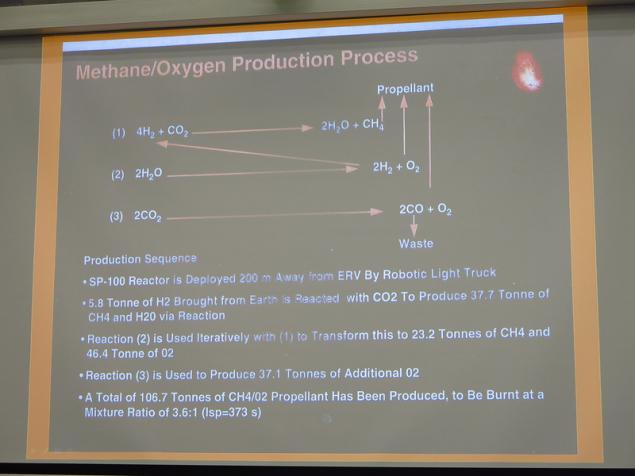
So we save considerably on the cargo, 18 times. We do not need to carry fuel on Mars. Thus, bringing a total of 6 tons of hydrogen, we get more than a hundred tons, or 95% of the fuel required for the return journey. In addition, we will get enough fuel, which will help us to conduct research on the Mars rovers using. We will produce enough fuel to bring the ship back to Earth and work on Mars. Chemical fuel has a much higher efficiency, and at a much better fuel engine is running. Probably not seem logical to transport such volumes of fuel on Mars. But if you get it right on Mars - is the practical aspect of the project immediately increased. It makes no sense to fly to Mars, if there is no opportunity for research. This production gives us an excellent product for the job.
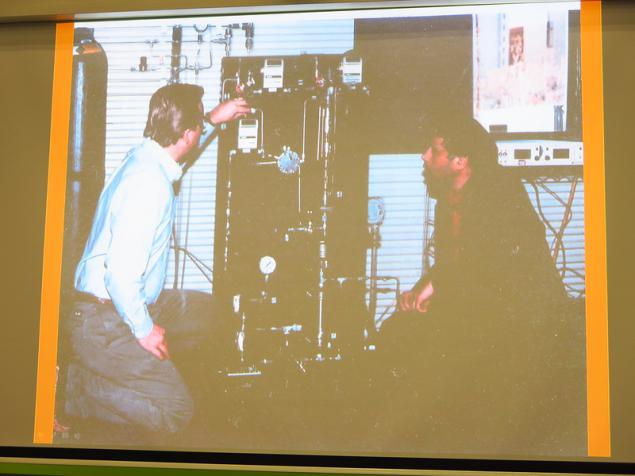
Many experts in the field of space considering this project as a fiction. But it's not magic, it is a very simple technology. It is much easier to technology output rocket into orbit. I proved this technology NASA, we have proved efficiency of this principle. Here, the model that we propose as a model for the fuel for the engine, which will send the capsule back to Earth. 8 months for delivery capsule to Mars, and 10 months will be produced fuel. And long before the new flight we know that Mars is already a rocket is the fuel that will be able to deliver the crew back to Earth. And if we know that this is not possible, then we will not run a third step. In two years we will launch two missiles - piloted vehicles and unmanned. And since we already have a reverse rocket, we do not need to use a huge heavy machine. We will be able to use the "tin can of" 8 meters in diameter and a height of 6 meters.

On the upper deck live astronauts, the first 'floor there are loads. There is a gym, a library, a laboratory, a bedroom and in the center - a refuge from solar radiation.

Two types of radiation can harm the crew. Solar flares from the sun and cosmic rays. Solar flares are constant, but the big occur once or twice a year, and they occur unpredictably. The probability that the outbreak will happen in 6 months' journey is very high. Solar radiation - protons, and to slow them down enough water layer thickness of 12 cm. We can equip a section in the middle of the ship, where the astronauts will be able to hide from the solar flare for a few hours, and screening asylum ship and its cargo. The nature of cosmic radiation we do not fully know. The strength of his huge, and energy, which charged particles of cosmic radiation, such that the layer of 12 cm will be insufficient, and the strength of the radiation there may be large. But though we, according to research, can assess the risk of cancer as a result of the radiation within the 1% because of the quantitative parameters of the radiation dose is not so great. Earth's magnetic field is too weak to effectively deflect cosmic rays are high-energy, the ISS crew receives half the dose of radiation because on the one hand, these rays blocks the planet itself. We measured the radiation, which is received at the station astronauts, and they do not receive a dose of radiation leading to disease. ISS works constantly and continuously, and we were able to conduct research that can be applied to our Mars mission and assume that it is not so dangerous.

There are other risks, dangerous for the crew, for example, zero gravity. Spacewalk involves some physical activity. You need to check the physical ability to perform such a flight crew. We conducted a test flight with unmanned, we have also created a simulator that can simulate gravity, which the crew will experience on Mars to estimate how changes in conditions will affect the physical abilities of the crew. During the flight the upper stage and the residential unit we connect cable 1500m to create artificial gravity. At a speed of one revolution per minute we can provide gravity similar to Mars. At a speed of 2 rpm we can reach the Earth's gravity. It will be necessary to provide medical and solutions to this problem. Stay crew all the time in zero gravity is very risky.

We considered using the path along which the ship will be able to reach Mars in 6 months. Why did we choose this path? When this trajectory ship can start returning to Earth after 2 years after the start of the crew from Earth. They respect the conditions of efficiency of flight, as every two years, the mutual position of the Earth and Mars is such that the flight is in the minimum time.
We have considered and risk factors. First, we are launching a drone, which begins to produce fuel and conduct research using robotic devices. Manned spacecraft is scheduled to arrive at the same point as the drone. What if the second device falls at a few hundred kilometers from the first one? We first unmanned rover is provided, which can deliver to our unmanned rocket. What if our ship landed much further than a hundred miles? We will have a version with a spare engine, which we equip manned spacecraft, and he will be able to deliver the crew drones. And even if we can not find the first unmanned, if you can not find the second drone, and the crew will land on Mars and will be forced to adapt to life on Mars, the missile will have everything you need for life on Mars for three years, during which we will be able to start another drone. Assume that the second unmanned land away from the rocket still we remain a fallback to the first rover. So, for the fifth year on Mars landed a second crew that will bring another drone. Every two years, Mars will be launched one manned and one unmanned, to ensure constant exploration of Mars.
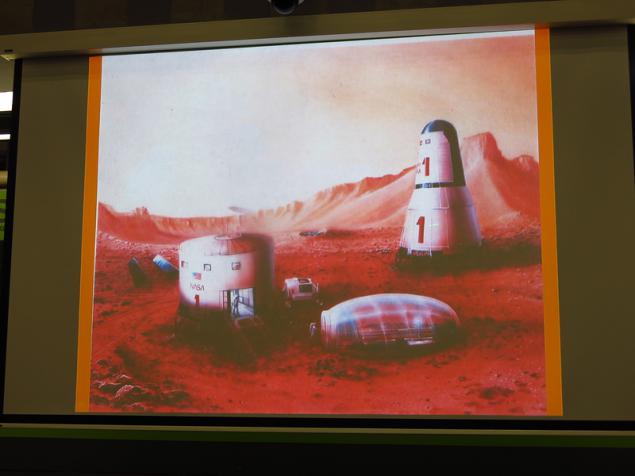
Let's see what it looks like base on Mars. Here we see the capsule for the return journey to Mars, here compartments for fuel. We see housing compartments for the crew, solar panels as a source of backup power and additional sources of backup power for the chemical plant. We tried to develop a project in such a way as to maximize the use of Martian resources. Duration of the mission on Mars crew will be a half years, this period is determined by the mutual position of the Earth and Mars, favorable for such a flight. I stand for flight planning so that the crew spent on Mars maximum possible time for research. It makes no sense to fly half a year and a month to come back. For eighteen months we will have a lot of research and find the fuel on Mars, and perhaps finally answer the question - is there life on Mars.
We know that on Mars once had oceans and rivers. There is ample evidence to prove that billions of years on Mars had water, and this time is enough life to begin. And if the true concept of the origin of life by chemical means, then we can check it. These missions will allow us to fly to Mars, conduct research to prove or disprove the hypothesis of the origin of life by chemical means. We will be able to conduct experiments that prove the possibility of evolutionary life from simple to complex compounds of elements. If we can set on Mars drilling rigs and achieve water level inside of Mars, we can create a suitable habitat. And if we look at the history of life on Earth, that once upon a time conditions on Earth were similar to those that have been on Mars. And maybe life is preserved in the depths of Mars, where there is water, or we can find traces of life in the past. All living things share the same amino acids, and although there are some differences, there are common aspects of life, and perhaps we will find similar on Mars and say that it's common for all aspects of organisms in space. Or we find evidence that chemical evolution does not always lead to the occurrence of life and that the DNA can not be formed only by chemical means and then earth experience is unique. But we can answer the questions that concern people for thousands of years. To do this, we need to get to Mars, drill ground, reach the water and carry out these studies. And after a year and a half of research we will be able to go back to Earth.
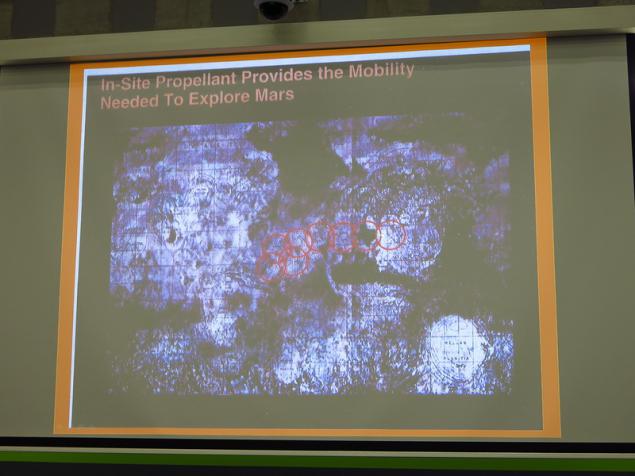
We'll leave the greenhouse and residential compartments on Mars. This is useful because we can use this equipment to continue to not bring it again to the earth. This is a map of Mars. Many Americans may want to take a trip to Mars. We have put a number of Texas map to indicate the scale and draw a circle with a diameter of 800 km. Not necessarily compare with Texas, it is comparable in size to France. These circles are within a day's journey, which can overcome the drone. We denote what area of Mars can be examined in the course of our missions. And we answer the question - and whether there is life on Mars - and could there be life on Mars.
This planet, land area which corresponds to the area of the Earth continents. It has all the resources. If we can get to Mars, then perhaps we can make Mars habitable - plant a forest and populate them, as do birds. I believe that this is possible. Life has the ability to transform the environment. So on Earth originated Geosphere and Biosphere. Life penetrates everywhere, how far can get. So life appeared in Hawaii, on the rocks far into the ocean. There birds brought the seeds were trees, and then there were people and the city. If people are playing the role of birds that ENTERED seeds of life - then, of course, this life is not the same as on Earth, and it does not happen within a generation.
That means for us to live among? I live in Colorado. Whether forests are inhabited Colorado? There you can get lost, there can not survive.
& Quot; In American history, the important role played by the pilgrims who came to Massachusetts in their honor every year we celebrate Thanksgiving. In the book, the governor of Massachusetts, William Bradforta, he wrote a book about the pilgrims that once something they did not like in the world, and they decided to move to a deserted place. Many have responded to this call, many were frightened and resisted this idea. And we can conclude that the great and worthy of veneration actions are always accompanied by severe hardship. This book describes the process of how beliefs helped to create an enclave of civilization in America. I> & quot;

Robert Zubrin (Mars Direct) and Sergei Zhukov (astronaut, head of the Skolkovo space cluster)
October 21, 2013 in Moscow, at a meeting of the Club of Friends of outer cluster Skolkovo Foundation, held a meeting with Robert Zubrin.
Robert Zubrin - American aerospace engineer and author. Project Leader Mars Direct and president Mars Society
Winner of a number of patents in the field of Aeronautics and Astronautics.
In 2010, Zubrin with Carl Sagan , Brian Cox and Penelope Boston have been shown in scientific video« The Case for Mars »project Symphony of Science.
Regalia: B.A. in Mathematics (1974), a M.S. in Nuclear Engineering (1984), a M.S. in Aeronautics and Astronautics (1986), and a Ph.D. in Nuclear Engineering (1992)
Zubrin Those of you who are interested in opportunities in the past missions to Mars have heard about the huge spaceships with grandiose huge engines that will be built for this purpose in orbit. Such technologies and work on this scale is not feasible in the near future. But I do not believe that such work is now necessary and appropriate. My colleagues and I considered various options spaceflight and different implementation of previous programs, good and bad. And we thought, why such a mission to Mars expensive. Of course, many developers want to sell their technology to carry out missions to Mars. But we need to review and select what is really expedient.

To build a ship, of course need a booster, which will bring it all into space. We and my colleagues tried to assess which components of the necessary and sufficient. We came to the conclusion that for a flight to Mars need four engines, two launch vehicle, and tanks with fuel and oxygen are the same as used in the project Saturn 5. There are different options for the location of engines. Such a construction would raise about 140 tons from the surface of the earth and deliver about 47 tons of cargo to Mars - these calculations were carried out in accordance with this carrying capacity. Until now, no one delivered a cargo space and forwards it to another planet. We just ran loads in near-Earth space. And if you make this kind of calculation, it is necessary to take into account all the stages of the path.

But if the mass of the ship and cargo weight to be delivered to Mars will not tens or hundreds of thousands of tons - if we can lift the weight from Cape Canaveral or other spaceports? Probably, it is possible to divide the cargo into 8 pieces, take them individually into orbit, to gather there and then deliver the goods to Mars. These projects were proposed previously, but now forgotten. The risk is too great - if at least one of the eight startups will fail - you will fail the entire mission. We are currently developing a mission with only two runs and thinking about the fact that both were successful launch. Not have to use just such missiles, but the class must be suitable capacity.
Why is being developed in other missions ships so great? Most ships are calculated taking into account the fuel to transport people to Mars and back. But here we can turn to the experience of travelers in the past. Do they always took with them all for yourself and expeditions, including the power of horses, all the way? No, the travelers were trying to be self-sufficient and get everything you need in place. Mars - the planet, which has the necessary resources and that can be a part of our process chain. Why do not travel light, and to facilitate the carrying capacity of our mission, we take as a basis for the concept of self-sufficiency.

First we went to Mars unmanned missiles and 40 tons of cargo. The rocket will fly to Mars, will slow down in the Martian atmosphere, and we Martian orbit with the help of a parachute capsule descended to the surface of Mars, as we have done so in 1996 and as Curiosity planted last year. We will deliver the goods, the capsule for the return flight from Mars, 5 meters in diameter, in which the two decks, a compartment for crew support for 4 people. This capsule is designed for travel from Mars to Earth for 6 months, and it will provide empty compartments for fuel.

Why do we send Slots? Otherwise, the weight of our apparatus would significantly increased. In these compartments will be 6 tons of hydrogen and a compartment with a small nuclear plant. After the rocket will land on Mars, a special robot will be able to deploy a nuclear power plant. When the power plant is established in the crater or recessed, we can start it and use it to run a chemical plant, which will produce carbon from the atmosphere and using hydrogen brought obtain methane. This is a known Sabatier exothermic reaction that does not require additional energy and passes it to the catalysts that we can also pick up. In this reaction, we obtain water and methane. Electrolysis of water, we get oxygen, which becomes fuel for the return trip and the remaining hydrogen, we will gather and store in a special compartment. Of carbon dioxide in the atmosphere of Mars, we also obtain oxygen by decomposing it into oxygen and carbon monoxide.

So we save considerably on the cargo, 18 times. We do not need to carry fuel on Mars. Thus, bringing a total of 6 tons of hydrogen, we get more than a hundred tons, or 95% of the fuel required for the return journey. In addition, we will get enough fuel, which will help us to conduct research on the Mars rovers using. We will produce enough fuel to bring the ship back to Earth and work on Mars. Chemical fuel has a much higher efficiency, and at a much better fuel engine is running. Probably not seem logical to transport such volumes of fuel on Mars. But if you get it right on Mars - is the practical aspect of the project immediately increased. It makes no sense to fly to Mars, if there is no opportunity for research. This production gives us an excellent product for the job.

Many experts in the field of space considering this project as a fiction. But it's not magic, it is a very simple technology. It is much easier to technology output rocket into orbit. I proved this technology NASA, we have proved efficiency of this principle. Here, the model that we propose as a model for the fuel for the engine, which will send the capsule back to Earth. 8 months for delivery capsule to Mars, and 10 months will be produced fuel. And long before the new flight we know that Mars is already a rocket is the fuel that will be able to deliver the crew back to Earth. And if we know that this is not possible, then we will not run a third step. In two years we will launch two missiles - piloted vehicles and unmanned. And since we already have a reverse rocket, we do not need to use a huge heavy machine. We will be able to use the "tin can of" 8 meters in diameter and a height of 6 meters.

On the upper deck live astronauts, the first 'floor there are loads. There is a gym, a library, a laboratory, a bedroom and in the center - a refuge from solar radiation.

Two types of radiation can harm the crew. Solar flares from the sun and cosmic rays. Solar flares are constant, but the big occur once or twice a year, and they occur unpredictably. The probability that the outbreak will happen in 6 months' journey is very high. Solar radiation - protons, and to slow them down enough water layer thickness of 12 cm. We can equip a section in the middle of the ship, where the astronauts will be able to hide from the solar flare for a few hours, and screening asylum ship and its cargo. The nature of cosmic radiation we do not fully know. The strength of his huge, and energy, which charged particles of cosmic radiation, such that the layer of 12 cm will be insufficient, and the strength of the radiation there may be large. But though we, according to research, can assess the risk of cancer as a result of the radiation within the 1% because of the quantitative parameters of the radiation dose is not so great. Earth's magnetic field is too weak to effectively deflect cosmic rays are high-energy, the ISS crew receives half the dose of radiation because on the one hand, these rays blocks the planet itself. We measured the radiation, which is received at the station astronauts, and they do not receive a dose of radiation leading to disease. ISS works constantly and continuously, and we were able to conduct research that can be applied to our Mars mission and assume that it is not so dangerous.

There are other risks, dangerous for the crew, for example, zero gravity. Spacewalk involves some physical activity. You need to check the physical ability to perform such a flight crew. We conducted a test flight with unmanned, we have also created a simulator that can simulate gravity, which the crew will experience on Mars to estimate how changes in conditions will affect the physical abilities of the crew. During the flight the upper stage and the residential unit we connect cable 1500m to create artificial gravity. At a speed of one revolution per minute we can provide gravity similar to Mars. At a speed of 2 rpm we can reach the Earth's gravity. It will be necessary to provide medical and solutions to this problem. Stay crew all the time in zero gravity is very risky.

We considered using the path along which the ship will be able to reach Mars in 6 months. Why did we choose this path? When this trajectory ship can start returning to Earth after 2 years after the start of the crew from Earth. They respect the conditions of efficiency of flight, as every two years, the mutual position of the Earth and Mars is such that the flight is in the minimum time.
We have considered and risk factors. First, we are launching a drone, which begins to produce fuel and conduct research using robotic devices. Manned spacecraft is scheduled to arrive at the same point as the drone. What if the second device falls at a few hundred kilometers from the first one? We first unmanned rover is provided, which can deliver to our unmanned rocket. What if our ship landed much further than a hundred miles? We will have a version with a spare engine, which we equip manned spacecraft, and he will be able to deliver the crew drones. And even if we can not find the first unmanned, if you can not find the second drone, and the crew will land on Mars and will be forced to adapt to life on Mars, the missile will have everything you need for life on Mars for three years, during which we will be able to start another drone. Assume that the second unmanned land away from the rocket still we remain a fallback to the first rover. So, for the fifth year on Mars landed a second crew that will bring another drone. Every two years, Mars will be launched one manned and one unmanned, to ensure constant exploration of Mars.

Let's see what it looks like base on Mars. Here we see the capsule for the return journey to Mars, here compartments for fuel. We see housing compartments for the crew, solar panels as a source of backup power and additional sources of backup power for the chemical plant. We tried to develop a project in such a way as to maximize the use of Martian resources. Duration of the mission on Mars crew will be a half years, this period is determined by the mutual position of the Earth and Mars, favorable for such a flight. I stand for flight planning so that the crew spent on Mars maximum possible time for research. It makes no sense to fly half a year and a month to come back. For eighteen months we will have a lot of research and find the fuel on Mars, and perhaps finally answer the question - is there life on Mars.
We know that on Mars once had oceans and rivers. There is ample evidence to prove that billions of years on Mars had water, and this time is enough life to begin. And if the true concept of the origin of life by chemical means, then we can check it. These missions will allow us to fly to Mars, conduct research to prove or disprove the hypothesis of the origin of life by chemical means. We will be able to conduct experiments that prove the possibility of evolutionary life from simple to complex compounds of elements. If we can set on Mars drilling rigs and achieve water level inside of Mars, we can create a suitable habitat. And if we look at the history of life on Earth, that once upon a time conditions on Earth were similar to those that have been on Mars. And maybe life is preserved in the depths of Mars, where there is water, or we can find traces of life in the past. All living things share the same amino acids, and although there are some differences, there are common aspects of life, and perhaps we will find similar on Mars and say that it's common for all aspects of organisms in space. Or we find evidence that chemical evolution does not always lead to the occurrence of life and that the DNA can not be formed only by chemical means and then earth experience is unique. But we can answer the questions that concern people for thousands of years. To do this, we need to get to Mars, drill ground, reach the water and carry out these studies. And after a year and a half of research we will be able to go back to Earth.

We'll leave the greenhouse and residential compartments on Mars. This is useful because we can use this equipment to continue to not bring it again to the earth. This is a map of Mars. Many Americans may want to take a trip to Mars. We have put a number of Texas map to indicate the scale and draw a circle with a diameter of 800 km. Not necessarily compare with Texas, it is comparable in size to France. These circles are within a day's journey, which can overcome the drone. We denote what area of Mars can be examined in the course of our missions. And we answer the question - and whether there is life on Mars - and could there be life on Mars.
This planet, land area which corresponds to the area of the Earth continents. It has all the resources. If we can get to Mars, then perhaps we can make Mars habitable - plant a forest and populate them, as do birds. I believe that this is possible. Life has the ability to transform the environment. So on Earth originated Geosphere and Biosphere. Life penetrates everywhere, how far can get. So life appeared in Hawaii, on the rocks far into the ocean. There birds brought the seeds were trees, and then there were people and the city. If people are playing the role of birds that ENTERED seeds of life - then, of course, this life is not the same as on Earth, and it does not happen within a generation.
That means for us to live among? I live in Colorado. Whether forests are inhabited Colorado? There you can get lost, there can not survive.
Tags
See also
Mars One fighting off criticism and requests $ 15 million
The project Mars One (Mars one)
Why Mars One participants are ready for one-way trip?
Member of «Mars One» denounced the organizers of the project, after which he was expelled from the program
The main problem in the realization of the project "Mars One"
Unfulfilled promises Mars One
Translation and dubbing video MARS ONE WAY
1058 candidates selected for the flight to Mars
Billionaire Donald Trump - is going to participate in the US presidential election.
Ukrainian student could become the first settler on Mars

















